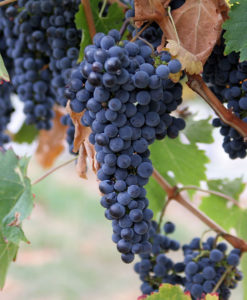
The Zinfandel grape has been growing in California for several centuries but its exact origins were unknown and frankly, nobody really cared. It was a grape that was easy to grow and less subject to many of the diseases that distress most vintners. The grape began to gain popularity during the prohibition period because it was prolific and could be easily sent around the country to winemakers for producing wines at home. As you can probably surmise, many grape growers pulled out the better known wine grape varieties in favor of planting Zinfandel that became the “cash crop” and saved the “old family vineyard” from foreclosure. With the end of prohibition, out came many of the Zinfandel planting in favor of better known wine grape varieties. The Zinfandel did remain a favorite of the makers of the less expensive red wines, which were often sold in one gallon containers and labeled as “Burgundy. Another property of the grape was that the skins could add color to a lighter colored red wine without dramatically effecting the flavor or aroma. As the prices of the traditional wine grape rose the price of the Zinfandel remained moderately low because it was just another “crap” grape. The grape also lost some of its popularity with many grape growers when it was also used to make a popular inexpensive sweet pink wine.
Some enterprising vintners began to take a second look at the Zinfandel and found that if it was handled as one would the better classical red grapes, a very nice dry wine could be made from it. At the forefront of the people who had faith in the Zinfandel was Dry Creek Vineyards, where the variety is treated with the respect and care that the Zinfandel truly deserves.
Dry Creek Vineyard 2014 Valley Heritage Zinfandel ($22). The Dry Creek Vineyard 2014 Heritage Zinfandel has been made from grapes from pre-prohibition vines that had been grafted onto new rootstock. Combining that with a creative style of winemaking that has been adopted by Dry Creek Valley Vineyards and you have a sure winner. Grapes from these vines produce wines that are heavy with all of the facets that make for a outstanding wine. The aroma of this wine is alive with cherry, blackberry, and cranberries, which carry over to the flavor where they merge with the flavors of black plums and spices. While the wine is full bodied, it is not very tannic and as is typical of all of the Dry Creek Vineyard wines, can be served with confidence and pride at any dinner table.
Dry Creek Vineyard 2013 Old Vines Zinfandel ($21). The ancient vines use in the making of this wine range in age from 95 to 110 years old and although they do not produce prolifically, they do produce grapes that are of superior quality. The wine made from these grapes seems to draw its aroma, flavor, and finese from the very soul of the grape. To add even more interest to this wine, the Dry Creek vintners blended 23% Petite Sirah and 2% Carignane to produce a finished wine that is truly a masterpiece. This wine has a deep and multi-leveled blackberry, blueberry, and cherry aroma with notes of vanilla and oak in the background, which continues on to the flavor and then ending in what could best be called a spectacular and incredibly long finish. This has to be one of the finest Zinfandel wines that we have tasted in a very long time.
 High Vacuum Engineer: Senior Technical Adviser and Feature Writer for Modern Photography Magazine (1967-1973), co-founder of Together Vineyards, an experimental vineyard in South Florida which was the southern most registered vineyard in the Continental United States. Co-Author of several books on Home Wine Making, Home Beer Making and Distillation of Spirits. Co-owner of Camera & Video Repair Institute in Sunrise Florida.
High Vacuum Engineer: Senior Technical Adviser and Feature Writer for Modern Photography Magazine (1967-1973), co-founder of Together Vineyards, an experimental vineyard in South Florida which was the southern most registered vineyard in the Continental United States. Co-Author of several books on Home Wine Making, Home Beer Making and Distillation of Spirits. Co-owner of Camera & Video Repair Institute in Sunrise Florida.